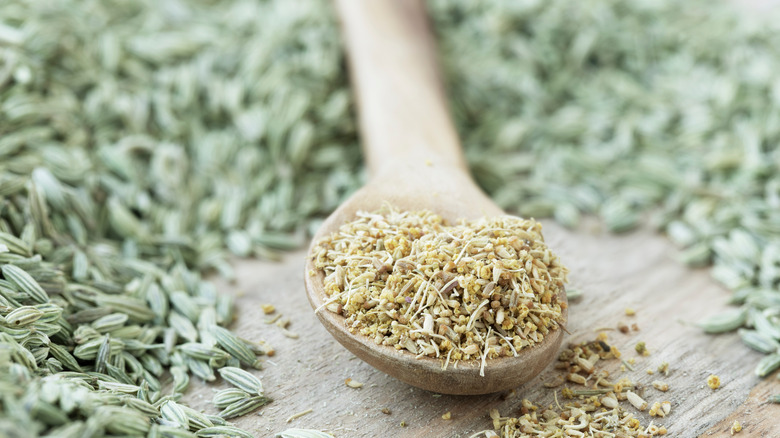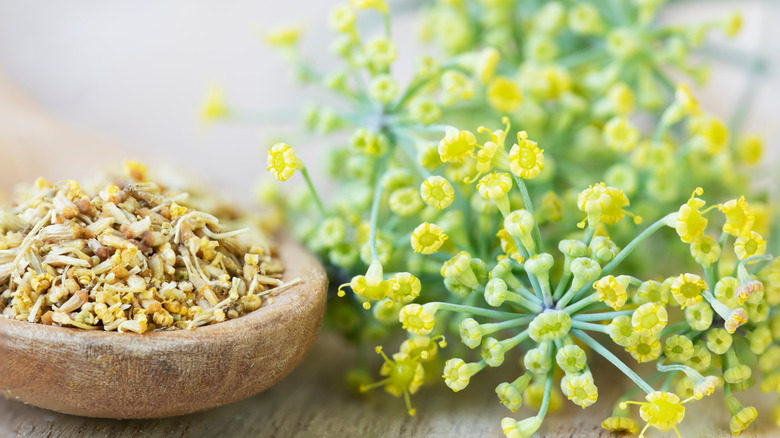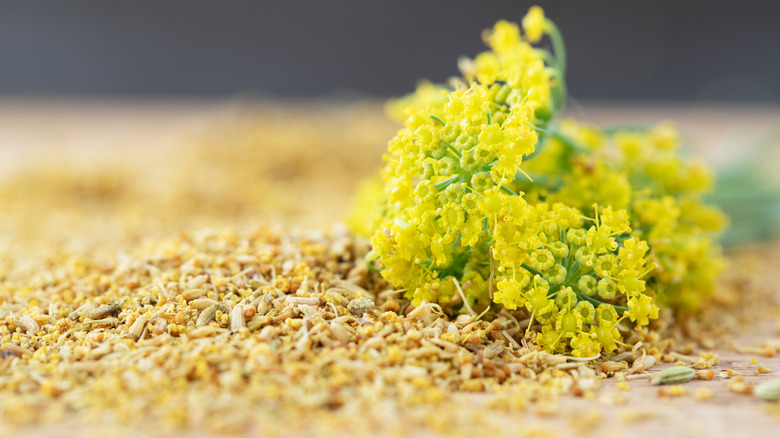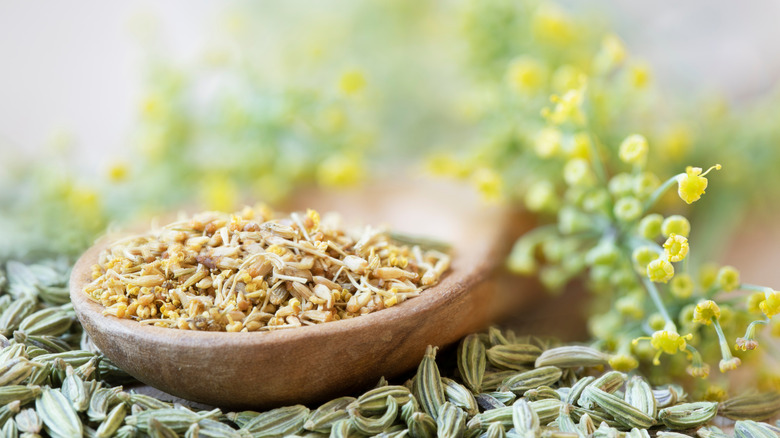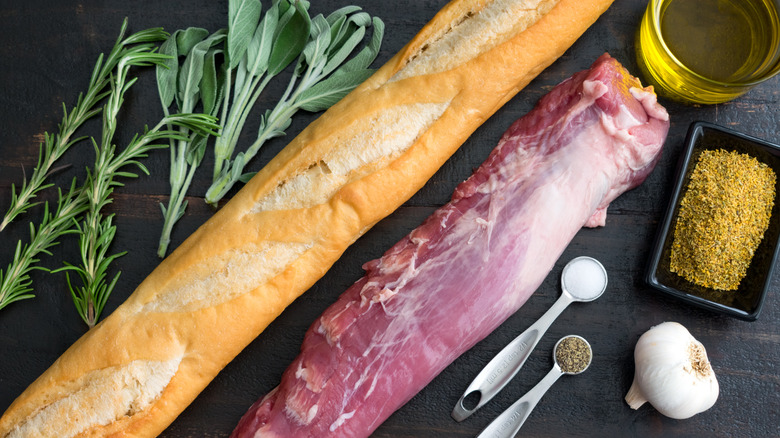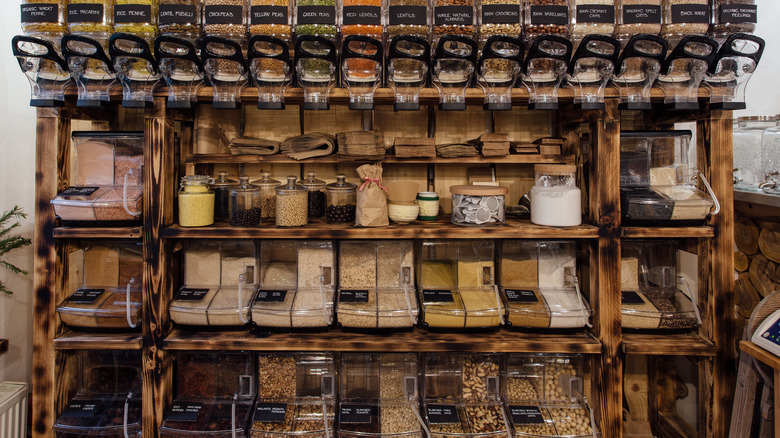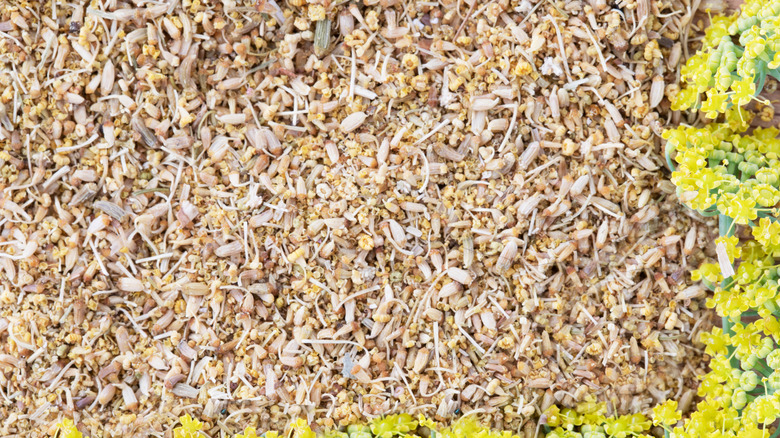What Is Fennel Pollen And How Can It Be Used?
We may receive a commission on purchases made from links.
There is certainly no shortage of delicious spices to flavor your dishes, both savory and sweet, but few can perfectly complement both. Fennel pollen has been nicknamed the spice of the angels, per Chieftain Wild Rice Company, due to its rich gold hue, incredibly versatile and unique flavor profile, and variety of applications in cooking and baking.
Fennel pollen refers to the pollen collected from fennel plant flowers, which are harvested from wild fennel plants either in the Mediterranean or the west coast in the United States, mostly California, according to Bon Appetit. While you may assume the spice may carry similar flavors of fennel, like licorice or anise, it's so much more complex than that. It's described as being spiced and earthy as well as bright and citrusy and pairs perfectly with almost every food imaginable. Keep reading to learn more about the ever-versatile and highly coveted fennel pollen.
What is fennel pollen?
Fennel pollen is almost exactly what it sounds like — pollen extracted from the yellow flowers that fennel plants grow, explains Regency Spices. Interestingly enough, however, it is usually only harvested from wild fennel. This is because fennel plants don't produce that much pollen at a time, and farming large amounts of the plant can be a little difficult.
More specifically, most fennel pollen comes from wild fennel flowers in Tuscany, which is where the highest quality fennel pollen can be found. Fennel pollen carries all the potent flavor of fennel bulbs, unlike fennel powder, which is another name for fennel seeds. Fennel pollen is considered somewhat of a luxury ingredient since the harvesting process is so time-consuming with low yields. Luckily, you usually only need a very small amount to get the flavorful effects, which pair wonderfully with and enhance both sweet and savory dishes (via Kitchn).
How is fennel pollen harvested?
The process by which fennel pollen is harvested is why it's so expensive. Most people are familiar with fennel as a plant and herb, which produces a large white base with green stocks somewhat similar in appearance to celery due to its feathery green leaves at the top. It has a very distinct licorice taste, and in home gardens, it's usually grown as an annual (via Bonnie Plants).
That being said, there is a very specific range of time in which you can collect the pollen from fennel, which is why wild fennel is preferable for collecting and selling it commercially. Wild fennel is found most often in the Mediterranean — Italy specifically, and Tuscany even more specifically — as well as the west coast in the United States, per Regency Spices.
However, gathering fennel pollen isn't too difficult. As The Atlantic explains, you can either shake the flowers into a bag to release the pollen or collect multiple flowers and dry them to produce dry pollen. The issue, though, is how little fennel each flower head produces — 1/4 teaspoon is considered a large yield.
What does fennel pollen taste like?
Fennel pollen is widely praised for its unique, rich, effective flavor. Common fennel is often described in comparison to spices like licorice or anise, which Bon Appetit affirms is also present in fennel pollen. The pollen's flavor notes don't stop there, though.
The pollen from fennel flowers, especially when fresh, also has a somewhat bright and sweet taste, described as being a little citrusy. It also has deeper, more intrinsically savory flavors, like saffron and pepper, according to Regency Spices. This complexity of flavors makes it a catch-all spice — you can add it to savory dishes to brighten and sweeten them or baked goods and sweets to make them a little more complex and gourmet. However, the floral, citrusy notes that fennel pollen is so praised for can be its downfall — too much of the spice can lead to an overly perfumy taste and aroma.
How to cook with fennel pollen
One of the reasons people love fennel pollen so much is because of its incredible versatility — there are very few foods you can't enhance with just a tiny sprinkle of the ingredient. It complements savory and sweet dishes with similar potency, and there's plenty of room to get creative. One great way to start is by simply sprinkling it on top of meats, recommends Pollen Ranch. For example, you could use fennel pollen as a dry rub on chicken, which will get further absorbed as it cooks.
It also goes great with more rustic, grain-based dishes — fennel pollen hails from the Mediterranean, so it makes sense that it would go well with staple Mediterranean ingredients like quinoa, bulgur, or couscous. The zesty and spiced flavor of fennel pollen is also a fantastic addition to any assortment of baked goods, with Kitchn citing muffins, bread (both savory and sweet), and fruit pies as great vessels for the unique spice.
Where to buy fennel pollen
Fennel and fennel seed are pretty easy to find at most grocery stores and supermarkets, but the same usually cannot be said for fennel pollen. Since it is so expensive, it's unlikely that you'll find your average supermarket carrying it in the spice aisles. If you want to find it in person, try your luck with specialty spice stores.
Your best bet is to purchase it online from a trusted retailer. One of the most well-reviewed fennel pollen sellers on Amazon is Pollen Ranch, which sells a 0.5-ounce container of fennel pollen for $11, or $22 per ounce. Italian-sourced fennel pollen tends to be the most coveted, though, per Regency Spices. One Italian fennel pollen on Amazon comes from Ritrovo Selections and costs $20 for 0.5 ounces, or $40 per ounce. Fennel pollen is quite expensive, but you only need a small amount for the flavor to be effective.
Nutritional information about fennel pollen
Fennel pollen isn't just a delicious and highly versatile spice — it's also good for your health. True fennel pollen doesn't have any calories, sugars, fats, proteins, vitamins, or minerals, per Chieftain Wild Rice Company, which is to be expected from most spices. Pollen itself, though, is often lauded for its multiple nutritional health benefits.
Pollen is believed to help reduce the risk of heart disease, boost your immune system, improve liver health, assist in healing wounds quicker, and has anti-inflammatory, anti-cancer, and antioxidant properties, according to Healthline. Fennel is also naturally high in lots of nutrients, including vitamin C and fiber, and fennel seed has long been used as a carminative, notes Pollen Ranch. So while fennel pollen specifically doesn't have any profound nutritional benefits, it also doesn't have any adverse health benefits. Additionally, it's gluten-free and vegan, making it a great way to flavor food if you have certain allergies or dietary restrictions.
